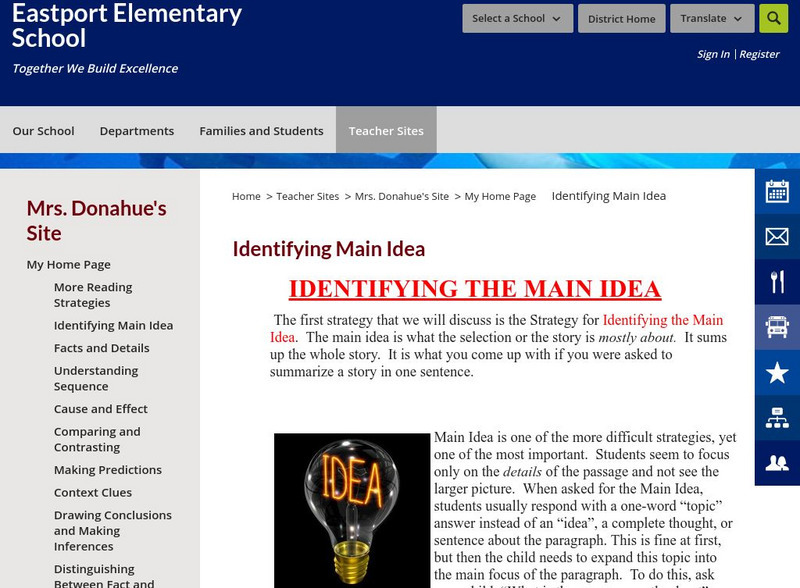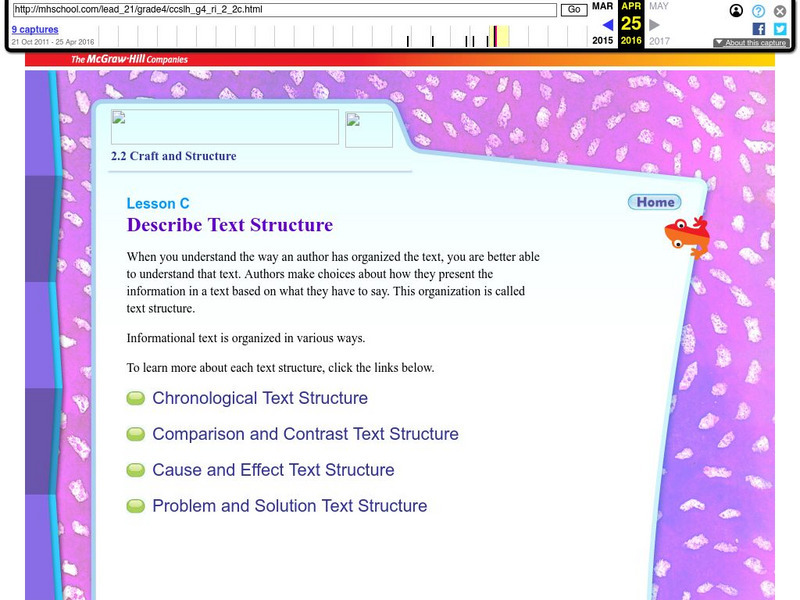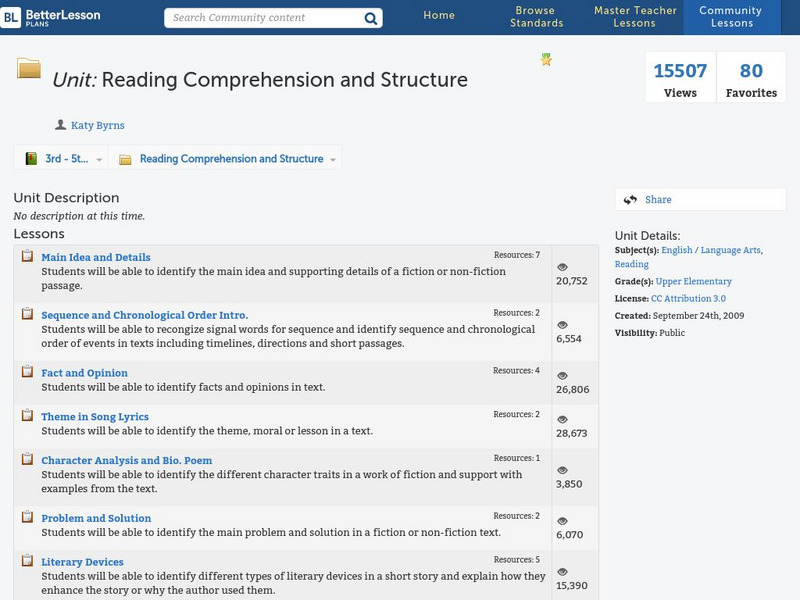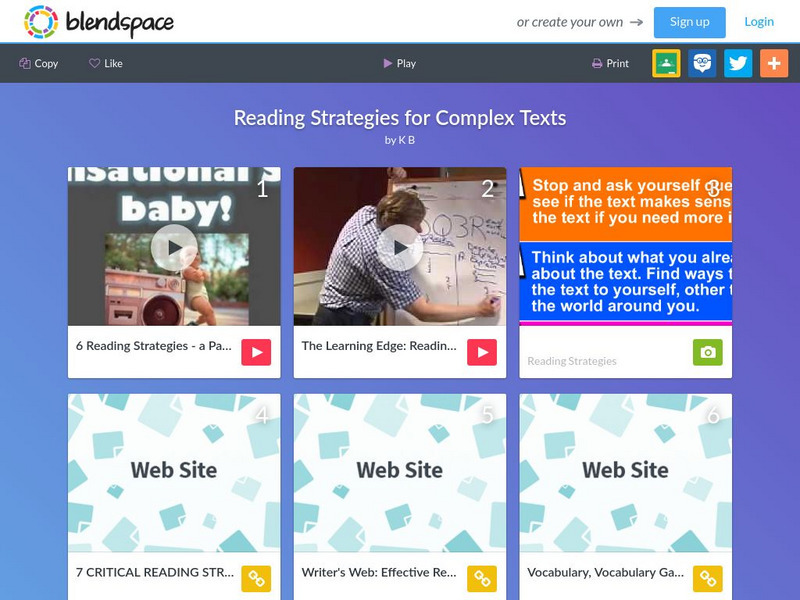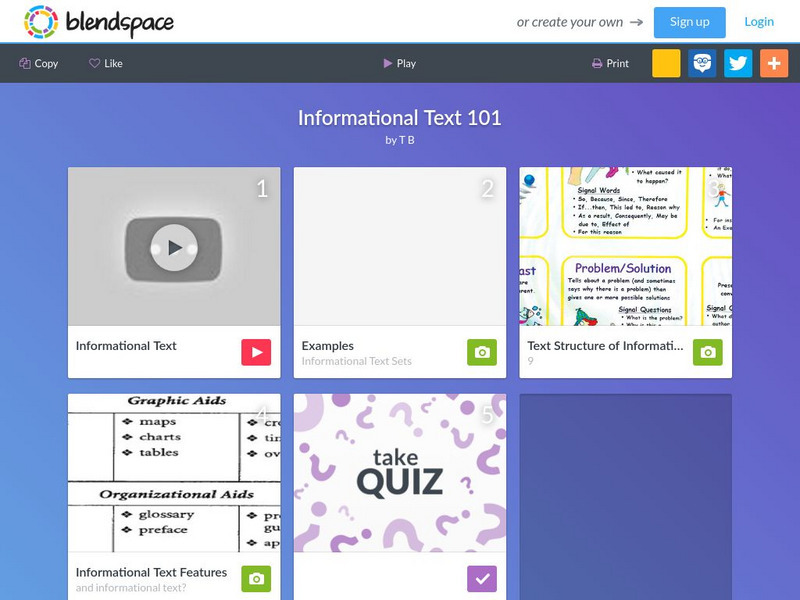Education.com
Education.com: W.4.9.b Worksheets: Apply Grade 4 Reading Standards to Info Texts
[Free Registration/Login Required] A site with links to 4 worksheets that can be downloaded and printed for student use while building skills with standard W.4.9.B: Apply grade 4 reading standards to information texts (e.g., Explain how...
Read Works
Read Works: Explore Our Solar System
[Free Registration/Login Required] This informational text passage shares facts about planets in the solar system. This passage is a stand-alone curricular piece that reinforces essential reading skills and strategies and establishes...
ArtsNow
Arts Now Learning: Musical Inferences [Pdf]
For this lesson, students will learn that inference is also present in music. They will examine music from different soundtracks to see how music is used to set the stage for events. They will describe how music gets louder, softer,...
Florida Center for Reading Research
Florida Center for Reading Research: Monitor for Understanding: Question Creation [Pdf]
A lesson plan in which young scholars read a text and create questions using the words provided on word cards. Materials are included.
Florida Center for Reading Research
Florida Center for Reading Research: Text Analysis: Inference Innovations [Pdf]
A lesson plan in which students read a text and use a graphic organizer to make inferences. Materials are included.
Florida Center for Reading Research
Florida Center for Reading Research: Exp. Text Structure: Main Idea [Pdf]
A lesson plan in which students read a text and then read it again highlighting the key words and phrases that are important for understanding the text. Materials are included.
Florida Center for Reading Research
Florida Center for Reading Research: Narrative Text Structure: Summary Step Up [Pdf]
A lesson plan in which learners read a narrative text and complete a graphic organizer to show the plot elements of the story. Materials are included.
Reading Rockets
Reading Rockets: Teach Expository Text Structure to Facilitate Comprehension
Expository text can be challenging to young readers because of the unfamiliar concepts and vocabulary it presents. Discover ways to help your students analyze expository text structures and pull apart the text to uncover the main idea...
Other
Eastport Elementary School: Mrs. Donahue's Site: Identifying the Main Idea
Information, examples, and practice passages to use while learning how to identify the main idea of an informational text.
Louisiana Department of Education
Louisiana Doe: Louisiana Believes: Ela Guidebooks: Accountable Talk
This strategy helps students refine their understanding of texts to meet reading expectations, engage in group conversations to meet speaking and listening expectations, and prepare for writing about texts.
Other
Ccss Literacy E Handbook: Informational Text: Use Details and Examples
A short explanation of how to use explicit details in an informational text to make inferences. Click on Model at the bottom right to see a model with examples.
Other
Ccss Literacy E Handbook: Informational Text: Summarize
A short explanation of how summarize an informational text. Click on the Model link to see an example summary with explanation.
Other
Ccss Literacy E Handbook: Informational Text: Understand Precise Vocabulary
A short explanation of the importance of using precise word choice in writing and using context clues to help you understand the meaning of precise words when reading. Click on Model to for an example with explanation and then click on...
Other
Ccss Literacy E Handbook: Informational Text: Understand Content Words
A short example of using context clues to determine the meaning of unfamiliar content words. Click on Practice to practice using context clues.
Other
Ccss Literacy E Handbook: Informational Text: Describe Text Structure
A short explanation of informational text structures. Follow links for more information on: chronological text structure, comparison and contrast text structure, cause and effect text structure, and problem and solution text structure....
Other
Ccss Literacy E Handbook: Informational Text: Reasons and Evidence in Text
A short explanation of using reasons and evidence as supporting details. Click the link to see a model of how to identify reasons and evidence in an informational text. Click on the Model button on the bottom right to see a model.
Quia
Quia: Context Clues
Read each sentence and use context clues to choose the meaning of the bolded word in this ten-question quiz.
Other
Reading Quest: Strategies for Reading Comprehension: Summarizing
Teach students to summarize nonfiction text with these lesson plans. Includes worksheets and activities that can be downloaded and printed.
Other
Strategies for Reading Comprehension:reciprocal Teaching
Use this page to understand the reciprocal teaching strategy that includes the role of the clarifier in student groups.
Scholastic
Scholastic: Teaching With Nonfiction: Teach Text Features
A brief lesson plan, this site offers an example of non-fiction text and a graphic organizer to help orient students to the features they need to use when reading for information.
SMART Technologies
Smart: Making Inferences
Inferencing is finding clues and using background knowledge to determine an explanation from facts in a passage or story. It's "reading between the lines" of a story to understand what the author doesn't state.
Better Lesson
Better Lesson: Unit: Reading Comprehension and Structure
This unit focuses on reading comprehension and structure. It includes lessons on the main idea and supporting details, theme, sequence, fact and opinion, literary devices, character, text features, inferences, organization of nonfiction,...
TES Global
Blendspace: Reading Strategies for Complex Texts
A nine-part learning module on reading strategies including links to videos, images, websites, and activities.
TES Global
Blendspace: Informational Text 101
A five-part learning module on informational text including links to a video, images, and an assessment.



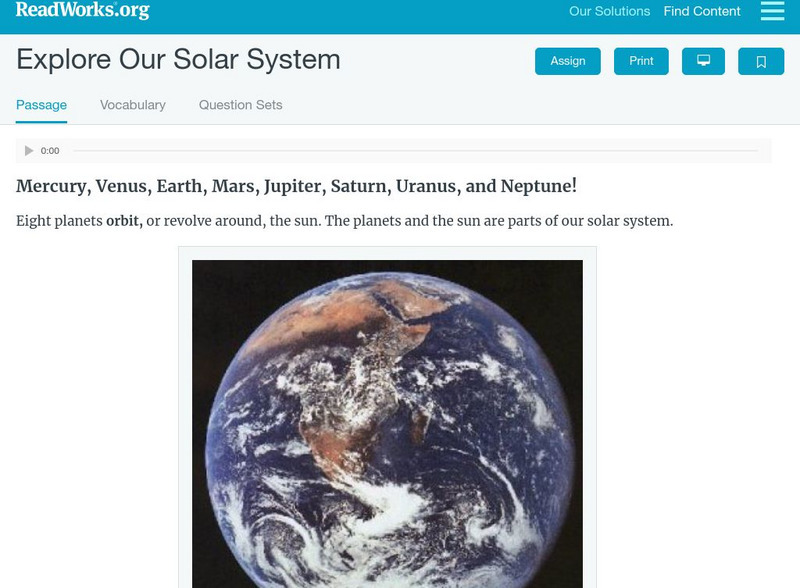
![Arts Now Learning: Musical Inferences [Pdf] Lesson Plan Arts Now Learning: Musical Inferences [Pdf] Lesson Plan](https://d15y2dacu3jp90.cloudfront.net/images/attachment_defaults/resource/large/FPO-knovation.png)
![Florida Center for Reading Research: Monitor for Understanding: Question Creation [Pdf] Lesson Plan Florida Center for Reading Research: Monitor for Understanding: Question Creation [Pdf] Lesson Plan](https://content.lessonplanet.com/knovation/original/509078-f113fac8eaf33259ad1320892a4af82b.jpg?1661787005)
![Florida Center for Reading Research: Text Analysis: Inference Innovations [Pdf] Lesson Plan Florida Center for Reading Research: Text Analysis: Inference Innovations [Pdf] Lesson Plan](https://content.lessonplanet.com/knovation/original/509090-40e85c5bfbfa31dce3d470a549282f99.jpg?1661786988)
![Florida Center for Reading Research: Exp. Text Structure: Main Idea [Pdf] Lesson Plan Florida Center for Reading Research: Exp. Text Structure: Main Idea [Pdf] Lesson Plan](https://content.lessonplanet.com/knovation/original/509112-af7e4c332bf039792a97bc877297d1cd.jpg?1661786955)
![Florida Center for Reading Research: Narrative Text Structure: Summary Step Up [Pdf] Lesson Plan Florida Center for Reading Research: Narrative Text Structure: Summary Step Up [Pdf] Lesson Plan](https://content.lessonplanet.com/knovation/original/509116-c9c6546ed67fc47f39cd0cad4fb48ffa.jpg?1661786948)
